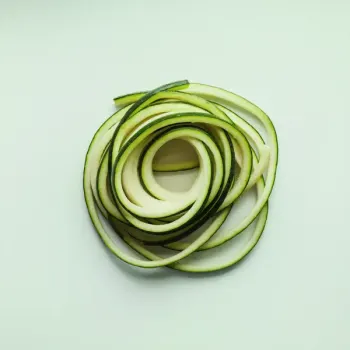Spaghetti Squash and Zucchini Noodles are nutritious, low-carb alternatives to traditional pasta, each offering a unique texture and flavor to a variety of dishes, from salads to casseroles.

Spaghetti squash is a winter squash that, when cooked, separates into strands resembling spaghetti noodles. Its mild flavor and al dente texture make it a versatile base for a variety of dishes.

Zucchini noodles, or 'zoodles', are made by spiralizing raw zucchini into thin strands. They offer a lighter alternative to traditional pasta and have a slightly sweet taste with a tender, yet firm texture.
The primary differences between spaghetti squash and zucchini noodles are their texture and flavor profiles. Spaghetti squash has a slightly crunchy, chewy texture and a mild, somewhat nutty flavor. Zucchini noodles are softer and have a more pronounced vegetal sweetness. Additionally, spaghetti squash is a winter squash, while zucchini is a summer squash.

Your ultimate Recipe Box, Meal Planner, and Cooking Class all in one
Best used in baked pasta dishes like casseroles or lasagna, where its texture holds up well. Expect a heartier dish with a subtle sweetness. Tip: Roast the squash beforehand to enhance its natural flavors. Ideal for lighter pasta dishes like pesto or aglio e olio. Zoodles cook quickly, so they're great when you want a meal in minutes. Tip: Sauté zoodles briefly to prevent them from becoming soggy.
Add a unique twist to cold pasta salads. Its firm texture adds an enjoyable crunch. Tip: Chill the cooked spaghetti squash before adding it to your salad. Zoodles can be eaten raw, adding freshness and a light, crisp texture to any salad. Tip: Toss zoodles with a bit of salt and let them sit to draw out excess moisture before adding to the salad.
Serve as a side with a drizzle of olive oil and herbs. It's an excellent accompaniment to protein dishes. Tip: Season with Parmesan and garlic for an extra flavor boost. Make a quick sautéed side dish with garlic and cherry tomatoes. It pairs well with fish and chicken. Tip: Keep the cooking time short to preserve the zoodles' texture.
Use it in place of noodles in soup for a gluten-free option. It holds its shape well in broth. Tip: Add spaghetti squash at the end of cooking to maintain its texture. Zoodles can be added to soups for a quick-cook vegetable that doesn't overpower the other ingredients. Tip: Spiralize zucchini directly into the pot just before serving.
Both spaghetti squash and zucchini noodles are low-calorie, nutrient-dense options that offer a variety of vitamins and minerals with the added benefit of being low in carbohydrates.
| Nutrient | Spaghetti Squash ( per 100 grams ) | Zucchini Noodles ( per 100 grams ) |
|---|---|---|
| Fat | 0.57g | 0.32g |
| Fiber | 1.5g | 1g |
| Sugar | 2.76g | 2.5g |
| Protein | 0.64g | 1.21g |
| Calories | 31 | 20 |
| Carbohydrates | 6.91g | 3.11g |
Spaghetti squash can replace pasta in many recipes, but it's best suited for dishes where a slightly crunchy texture is desirable.
Yes, both are low in carbs and suitable for a ketogenic diet.
Sauté them quickly over high heat, and avoid overcooking. You can also salt them beforehand to draw out excess moisture.
Zucchini noodles can become mushy when frozen and thawed. Spaghetti squash freezes better, but it's best to undercook it slightly if you plan to freeze it.
Cut the squash in half lengthwise, remove the seeds, and roast it cut-side down until tender. Once cool, use a fork to scrape out the strands.